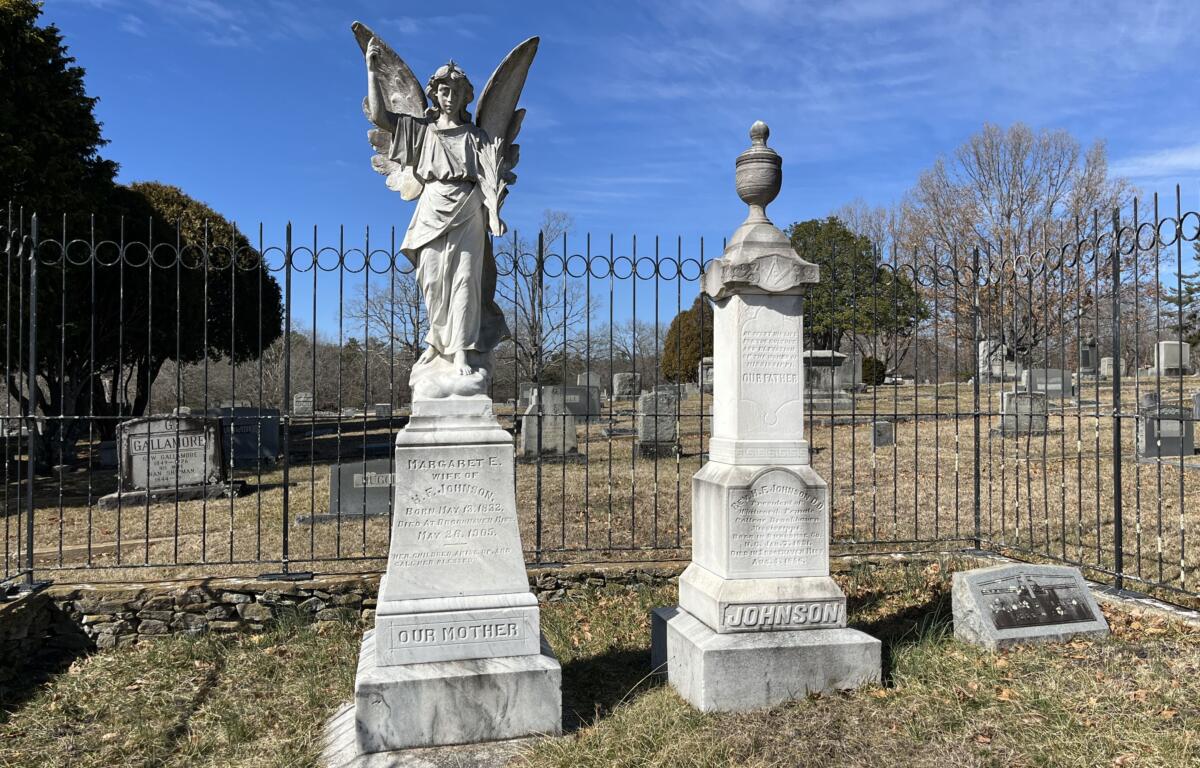EDITOR’S NOTE: Everyone has a story — some more well-known than others. Across Western North Carolina, so much history is buried below the surface. Six feet under. With this series, we introduce you to some of the people who have left marks big and small on this special place we call home.
The statue described in Thomas Wolfe’s critically acclaimed first novel, “Look Homeward, Angel,” stands above Margaret E. Bates Johnson (1832-1905), grandmother of Vernon and Leander Johnson. The famed Hendersonville brothers deeded their family farm to the county school system for historical education.
The Johnson Family
Mandy Gibson, Executive Director of Historic Johnson Farm Foundation, Inc, is currently drafting a new book, utilizing primary sources to illustrate the history of the educational farm she operates and the people who once called it home.
Gibson’s research has produced a genealogy of the family. Noble and James Johnson first settled in Henderson County in 1798. Noble’s grandson, Rev. Dr. Harvey Fletcher Johnson (1831-1886), married Margaret Bates. The Johnson’s had nine children.
Rev. Johnson was ordained as a Doctor of Divinity. He served as the president of Whitworth Female College in Brookhaven, Mississippi, where he and his wife, Margaret, lived.
After her husband died, Margaret Johnson remained in Brookhaven until her death on May 26, 1905. Her body was transported to Hendersonville to be interred beside her husband. They are buried side by side behind a wrought iron fence in Oakdale Cemetery.
One of Rev. and Mrs. Johnson’s daughters, Sallie, married Junius Hart, although he seems to have died relatively early. Before he passed, the couple had two sons: Vernon and Leander. Vernon is buried next to his mother, Sallie, in Oakdale Cemetery. A marker for Leander is there too, although his ashes were scattered on the Johnson farm.

“Look Homeward, Angel”
Who bought the angel statue from W.O. Wolfe, Thomas Wolfe’s father, that stands above the late Mrs. Johnson has been debated. Some sources claim it was ‘a sister,’ although said sources fail to indicate which sister. Another theory is Johnson’s daughter, Sallie, bought it for her mother, although Sallie had financial troubles as a single mother.
“Two of their daughters, Sallie Hart and Katie Toms, purchased an angel statue for Margaret’s grave in 1906 from Asheville stone-cutter W.O. Wolfe,” explained Johnson family historian Mandy Gibson. “The women had asked Wolfe for photographs of some of his monuments, and they selected one not made by Wolfe but rather purchased by him from Italy. They bought the angel, made of Carrera marble, for $1,000. It had been sitting on the porch of the shop for years.”
Adjusted for inflation, the statue would have cost around $35,000 in 2025 dollars.
Margaret Johnson’s statue has been identified as the “Look Homeward, Angel” for several reasons. Find out why with “Strangeville: Where is Wolfe’s ‘Look Homeward, Angel?”
“In 1973, a young man named David Lubin accidentally broke a wing and a hand on the monument,” wrote Gibson. “He immediately went to the police and then went to the farm to apologize to Margaret Johnson’s grandsons, Vernon and Leander.” The damages Lubin caused were mended with epoxy.

The Historic Johnson Family Farm
Relatives of Harvey and Margaret Johnson had a homestead in Henderson County.
“The handmade brick farm house was constructed in 1880 and an additional house was added in 1923,” as explained by Blue Ridge Heritage. The home is on the National Register of Historic Places and is thought to be the oldest remaining brick home in Henderson County.
The house was used as a boarding house for decades, first run by Sallie Johnson, then by her sons Vernon and Leander. Meanwhile, the property operated as a tabaco farm.
“Visitors helped with farm chores but also enjoyed front porch rocking chairs, cool evenings, square dances, and Sunday ice cream,” according to Blue Ridge Heritage. “During its heyday,” wrote the Hendersonville Times-News on April 16, 2006, “a room with three mouth-watering meals cost $5 a week.”
Vernon and Leander were bachelors. Each were college-educated; Leander had a degree in chemical engineering, which he used in World War II, and Vernon had a degree in mechanical engineering, which he appears to have never used.
“The brothers enjoyed the field trips schoolchildren frequently made to the farm. They offered to will the farm to Western Carolina University, but the university did not accept the offer,” explained Henderson Heritage. Instead, they willed the property to Henderson County Public Schools.

“Rugby Middle School and parts of West High School,” according to Hendersonville historian Mary Jo Padgett, were built on land donated by the bachelor brothers.
“Today, [the farm] is managed by the non-profit Henderson County Education Foundation,” wrote the Times-News. “Annually, 2,000 schoolchildren come to the farm for field trips. Historic Johnson Farm is one of three farms nationwide owned by a public school system.”
The farm’s website reads, “It offers school field trips, historic home tours, nature trails, picnic tables, animals and 10 historic structures on 15 acres of forest, fields, and streams.” Tours are available of the grounds upon request. It can be visited at 3346 Haywood Road in Hendersonville.
The history of W.N.C. is fascinating. Learn more with these articles:


